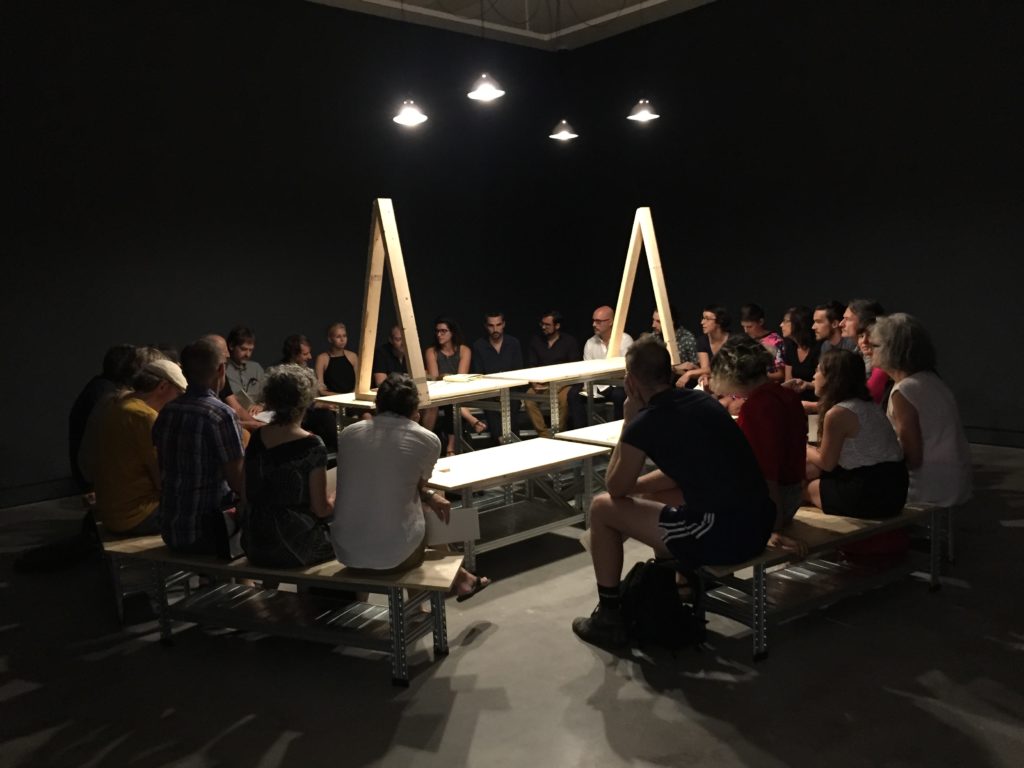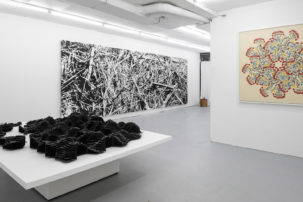A contract is designed to be airtight. It aims to anticipate every procedural technicality and predict future interpretations. During the current “legal moment” in the history of contemporary art, artists are finding opportunities for flexibility when working within legal constraints. “The Radical Imaginary: The Social Contract” explores the function, potential and failure of the artist’s contract. Works by Agency, Carlos Amorales, John Boyle-Singfield, Jill Magid, Milo Rau and Carey Young identify and occupy potential loopholes within the legal system. Whether by circumventing copyright agreements or challenging the commodification of property and labour, works in the exhibition highlight how artistic agency can subvert the contractual structures that so often bind it.
Text-based works by Carey Young demarcate the gallery space, declaring that the viewer agrees to a set of terms by entering a section of the gallery. In Obsidian Contract (2010), for example, Young establishes a contract with the viewer, stating: “By viewing your reflection within this black mirror for longer than ten seconds, you declare and agree that the space visible to you within the mirror is common land.” Young’s Declared Void II (2013) cordons off a corner of the gallery that when entered signals a mutual agreement that the viewer is temporarily a US citizen. These active social contracts require the viewer to use their body as a vote, negotiating and disrupting boundaries of the commons and nation states alike. Jill Magid’s The Proposal (2016), part of her ongoing project The Barragán Archives, offers an inside view on the complex legal legacy of iconic Mexican architect Luis Barragán. After Barragán’s death in 1988, his professional archive was allegedly purchased as a gift (in lieu of an engagement ring) for Frederica Zanco by her fiancé, Rolf Fehlbaum, the chairman of Swiss furniture maker Vitra. This private archive remains in Switzerland, where Zanco retains exclusive copyright to Barragán’s architectural records. In The Proposal, Magid offers Zanco a diamond ring fashioned from Barragán’s cremated remains in exchange for the public’s right to access the archive, trading Barragán’s body for his body of work. The archive symbolizes a romantic promise between Zanco and her husband, and Magid’s negotiation reflects this romantic sensibility. But it would be naive to assume that the artist’s role is simply to inject some personal warmth into the stalled negotiations to return the archive to public hands. Sentimentality is not simply a balm to soothe the failures of a broken judicial system. On the contrary, Magid activates the latent romantic potential that already exists within the legal system itself, by pushing the boundaries of what legal discourse can express and communicate.
Works by Agency and Milo Rau challenge a nation’s right to stake claim over the property, labour and life of its citizens. For Assembly Thing 002296 (Mount Whymper) (2018), Agency convened a public assembly—including an ex-inmate, a penitentiary cultural programmer, a criminologist and a copyright lawyer—in the gallery space in response to Hawley v. Canada, a case in which, through a broad legal standard known as “Crown copyright,” the crown claimed ownership over an artwork created by an incarcerated artist during his sentence. In the documentary The Congo Tribunal (2017), theatre director Milo Rau staged an international tribunal on war crimes and resource extraction in Congo, centred on a 2014 massacre in the city of Bukavu. By gathering government ministers, activists, soldiers, miners and rebels, all either eyewitnesses or otherwise implicated in the killings, Rau unravels the complex multinational interests and nefarious local agreements behind conflict and exploitation, while pointedly acknowledging that such tribunals are often organized by the perpetrators to exclude the parties most deeply impacted by the results.
In response to The Congo Tribunal, curator Marie J. Jean asks, “What prompts an artist to stage this type of work, appropriating the conceptual and political apparatus of the judicial system?” I wonder whether appropriation is the right term for the complex act of claiming that occurs again and again in the exhibition. Do artists simply cloak themselves in judiciary personas, appropriating a legal apparatus as a mere artistic tool? Are we witnessing artistic interpretations of legal structures, or could the works themselves be acts of justice? Do artists point to the inadequacies of the judiciary system, or do they enact their own? Rather than creating loopholes within an existing legal system, artists act as cultural brokers in order to ratify a new civil code, and activate the creative and critical potential of the radical imaginary.

Agency, Assembly Thing 002296 (Mount Whymper). Installation view, Assembly (The Radical Imaginary: The Social Contract), VOX, 2018. Photo: Jean-Marc Perin.

 Carey Young, Declared Void II, 2013. Site-specific vinyl installation, dimensions variable. Courtesy Paula Cooper Gallery, New York. © Carey Young
Carey Young, Declared Void II, 2013. Site-specific vinyl installation, dimensions variable. Courtesy Paula Cooper Gallery, New York. © Carey Young





